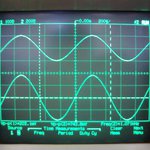First Version
Dependencies: EthernetInterface mbed-rtos mbed
Codes/Capture.cpp
- Committer:
- rebonatto
- Date:
- 2016-03-07
- Revision:
- 3:94a128e0f316
- Parent:
- 2:bf4bbf7d6793
File content as of revision 3:94a128e0f316:
/*
* Capture.h
*
* Created on:
* Author:
*/
#include "Capture.h"
__attribute((section("AHBSRAM1"),aligned)) float Capture::m_AdcBuffers[NUMBER_OF_CHANNELS][NUMBER_OF_SAMPLES];// __attribute__((section("AHBSRAM0")));
bool Capture::flag_capture = 0;
int Capture::cnt_buffer=0;
int Capture::channel_number=0;
int Capture::cnt_interrupt=0;
Serial rfid_serial(p28,p27);
Ticker timer_interrupt;
DigitalOut led1(LED1);
float Capture::GetValue(int nsamples, int nchannel)
{
return m_AdcBuffers[nchannel][nsamples];
}
void Capture::PutValue(int nsamples, int nchannel, float value)
{
m_AdcBuffers[nchannel][nsamples] = value;
}
void Capture::CopyBuffer(int channel, float *dest)
{
memcpy(dest, &m_AdcBuffers[channel][0], sizeof(float) * NUMBER_OF_SAMPLES);
/*
for(int i=0;i<NUMBER_OF_SAMPLES;i++)
{
dest[i] = GetValue(i,channel);
}
*/
}
void Capture::InitializeAD()
{
init_adc(200000); // Inicializa o AD com a frequencia de amostragem de 200 kHz
LPC_ADC->ADCR &= ~ADC_MODE_BURST; // Desabilito o modo burst de captura para utilizar apenas a captura simples
NVIC_DisableIRQ(TIMER3_IRQn); // Desabilita a interrupção do Timer3
}
void Capture::AcquireValues()
{
NVIC_DisableIRQ(TIMER3_IRQn); // Desabilita a interrupção do Timer3
timer_interrupt.attach_us(&Capture::FcnTimerInt,11); // Seta a interrupção do timer3 para cada 11us apontando para a função FcnTimerInt
cnt_buffer = 0;
cnt_interrupt = 0;
flag_capture = 0;
channel_number = 0;
LPC_ADC->ADCR |= ADC_START_NOW; // Habilita a captura do A/D -> Captura Simples
//printf("\r\nPASSOU do init \n");
select_channels(1<<channel_number); //
NVIC_EnableIRQ(TIMER3_IRQn); // Habilita a interrupção do timer 3
for(volatile int i=0; i<100000; i++); // Gasta tempo
while(!flag_capture);
/*for (int i=0;i<NUMBER_OF_SAMPLES;i++)
{
printf("\r\n%d", i);
for (int j=0;j<6;j++)
{
float val = 0;
val = (float)m_AdcBuffers[j][i] - (float)Settings::get_Offset(j);
val /= (float)Settings::get_Gain(j);
//printf("\t%f", m_AdcBuffers[j][i]);
printf("\t%2.2f", val);
}
}*/
//printf("\n");
}
extern "C" void Capture::FcnTimerInt(void)
{
if (cnt_interrupt < 120) // Descarta as primeiras leituras para estabilizar as leituras do A/D
{
while(!(LPC_ADC->ADGDR>>31));
m_AdcBuffers[channel_number][0] = ((LPC_ADC->ADGDR>>4)&0xfff);
if (channel_number < 5)
{
channel_number++;
}
else
{
channel_number = 0;
}
cnt_buffer = 0;
cnt_interrupt++;
select_channels(1<<channel_number);
LPC_ADC->ADCR |= ADC_START_NOW;
}
else //Armazena as leituras no buffer dos canais
{
while(!(LPC_ADC->ADGDR>>31)); // Aguarda o bit de DONE ser setado no registrador ADGDR sinalizando o final de uma captura
if (cnt_buffer < NUMBER_OF_SAMPLES)
{
//Pega o valor do AD e adapta de 16 bits para 12 bits
m_AdcBuffers[channel_number][cnt_buffer] = (float) ((LPC_ADC->ADGDR>>4)&0xfff);
if (channel_number < 5)
{
channel_number++;
}
else
{
channel_number = 0;
cnt_buffer++;
}
}
else
{
flag_capture = 1;
NVIC_DisableIRQ(TIMER3_IRQn);
//timer_interrupt.detach();
}
select_channels(1<<channel_number);
LPC_ADC->ADCR |= ADC_START_NOW;
}
}
void Capture::ReadRFID(int channel,char *rfid)
{
char cmd[4];
cmd[0] = 'S';
cmd[1] = '0'+channel;
cmd[2] = '\n';
cmd[3] = '\0';
//send
rfid_serial.puts(cmd);
//receive
char ch=0;
char ans[10];
int cnt=0;
int tmout=1000;
while(ch != '\n' && tmout-- && cnt<9)
{
if(rfid_serial.readable())
{
ch = rfid_serial.getc();
if(!((ch>='0' && ch<='9') || (ch >= 'A' && ch <= 'F')))ch='0';
ans[cnt++] = ch;
}
else
wait_ms(1);
}
ans[cnt-1] = '\0';
for(int i=0;i<9;i++)
rfid[i] = ans[i];
}


